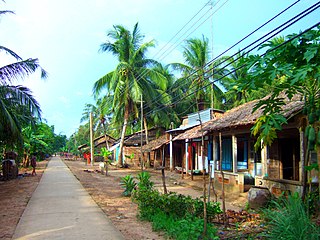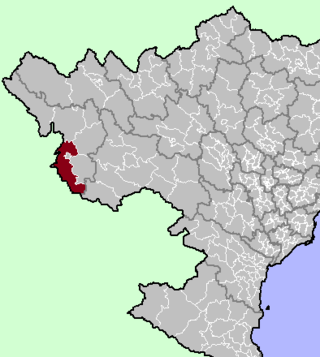Related Research Articles

On the first tier, Vietnam is divided into fifty-eight provinces and five municipalities under the command of the central government. Municipalities are the highest-ranked cities in Vietnam. Municipalities are centrally-controlled cities and have special status equal to the provinces.
Articles related to Vietnam and Vietnamese culture include:

Sóc Trăng is a province in the Mekong Delta of Southern Vietnam, with its capital in Sóc Trăng. The province occupies an area of 3,298.20 km2 (1,273.44 sq mi) and has a population of approximately 1,213,400.

Khánh Hòa is a southern coastal province in the South Central Coast region, the Central of Vietnam. It borders Phú Yên to the north, Ninh Thuận to the south, Đắk Lắk to the west, Lâm Đồng to the southwest and the East Sea to the east.

Gia Lai is a northern mountainous province in the Central Highlands region, the Central of Vietnam. It borders Kon Tum in the north, Quảng Ngãi in the northeast, Bình Định in the east, Phú Yên in the southeast, Đắk Lắk in the south and Ratanakiri of Cambodia in the west.

Phú Mỹ is a district-level town of Bà Rịa–Vũng Tàu province in southeast Vietnam. As of 2018 the town had a population of 175,872. The town covers an area of 333.84 km².

Vietnam is a dynamic developing economy with a relatively high growth rate. The energy sector plays a key role in promoting the country's socio-economic development. Vietnam has a diverse energy fuel resource of various types such as coal, natural gas, petroleum, hydropower and renewables such as solar and wind energy. The country has recently been successful in renewable energy deployment, especially solar and wind power development. Coal has been the key power generation source since 2018. Coal accounted for about 30% of installed capacity and 47% of electricity generation in 2021 The high use of coal makes Vietnam an increasingly important emitter of carbon dioxide, contributing to climate change.

Vietnam Electricity is the national and the sole public power company in Vietnam. It was established by the government of Vietnam as a state-owned company in 1994, and has operated officially as a one-member limited liability company since 2010.

The Mường Thanh Valley is a valley located in the Điện Biên Province of Northwestern Vietnam. The valley is approximately 20 km long by 5 km wide. A heart-shaped basin, the valley is surrounded by a region filled with jungles, rice paddies, and lakes. Located within the Mường Thanh Valley is the city of Điện Biên Phủ. The capital of Điện Biên Province, Điện Biên Phủ, is famous as the site of a decisive battle in 1954 in which French forces were defeated by Việt Minh troops under general Võ Nguyên Giáp.

Điện Biên is a district of Vietnam's Điện Biên province. As of 2019, it had a population of 93,850 people, covering an area of 1395.99 km², making it the most populous district in the province. The district capital lies at Thanh Xương. It is bordered by Sơn La province, Mường Chà district, Điện Biên Đông district, Điện Biên Phủ, and Phongsaly province of Laos.
The Trung Sơn Dam is a hydroelectric power station on the Ma River in northwestern Vietnam. Located in the Trung Sơn commune, Quan Hóa District, Thanh Hóa Province, it is approximately 95 kilometres (59 mi) southwest of Hòa Bình city, and 195 kilometres (121 mi) northwest of Thanh Hóa city. The dam created a reservoir which covers a large area of the Mường Lát and Quan Hóa Districts in the Thanh Hoa province as well as part of the Mộc Châu District in Sơn La Province. It is approximately 9.5 kilometres (5.9 mi) from the Vietnam–Laos border. The 260 MW associated power plant became fully operational in September 2017.
Vietnam utilizes four main sources of renewable energy: hydroelectricity, wind power, solar power and biomass. At the end of 2018, hydropower was the largest source of renewable energy, contributing about 40% to the total national electricity capacity. In 2020, wind and solar had a combined share of 10% of the country's electrical generation, already meeting the government's 2030 goal, suggesting future displacement of growth of coal capacity. By the end of 2020, the total installed capacity of solar and wind power had reached over 17 GW. Over 25% of total power capacity is from variable renewable energy sources. The commercial biomass electricity generation is currently slow and limited to valorizing bagasse only, but the stream of forest products, agricultural and municipal waste is increasing. The government is studying a renewable portfolio standard that could promote this energy source.

Lý Hùng is a Vietnamese former vovinam artist, actor, film director, producer, entrepreneur, philanthropist, activist and sometimes singer.
The TTC Phong Dien Solar Power Plant is a solar power plant built in Hoà Mỹ village, Dien Loc commune, Phong Điền District, Thừa Thiên-Huế Province, Vietnam.
The BP Solar 1 Power Plant is a solar power plant built on Phuoc Huu commune, Ninh Phuoc district, Ninh Thuan province, Vietnam.
Srepok 1 is a solar power plant built on the land of Ea Wer commune, Buon Don district, Dak Lak province, Vietnam.
The Cam Hoasolar farm is a solar power plant built on the land of Cam Hoa commune, Cam Xuyen district, Ha Tinh province, Vietnam.
LIG Quang Tri is a solar power plant built on the land of Gio Hai and Gio Thanh communes, Gio Linh district, Quang Tri province.

Quyết Tuấn is a journalist, social activist, ornamental plant expert, and rural development expert in Vietnam. He is currently the editor-in-chief of the Journal of Rural Development Science, head of the Department of Culture and Development E-Magazine, and chief of staff of the Hanoi Ornamental Plant Association, Director of the Institute of Art, Culture and Economics Vietnam.
References
- 1 2 "Khánh thành nhà máy điện mặt trời TTC Krông Pa". TUOI TRE ONLINE (in Vietnamese). 2018-12-05. Retrieved 2019-10-17.
- 1 2 "Nhà máy điện mặt trời TTC Krông Pa công suất 49 MW (69 MWp)". Báo Thanh Niên (in Vietnamese). 2018-12-02. Retrieved 2019-10-17.